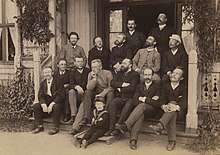Niels Johan Føyn
Niels Johan Føyn, original surname Nielsen (February 23, 1860 – June 13, 1945) was a Norwegian meteorologist.
Niels Johan Føyn | |
|---|---|
 | |
| Born | Niels Johan Nielsen February 23, 1860 |
| Died | June 13, 1945 (aged 85) |
| Nationality | Norwegian |
| Occupation | Meteorologist |
Føyn was born in Slagen in the municipality of Tønsberg, Norway.[1][2] He was the son of the ship operator Peder Nielsen (1818–1904) and he later adopted the surname Føyn from the oeconym of the farm where his family lived.[2] He received his candidatus realium degree in 1886 and then worked as an assistant at the Norwegian Meteorological Institute.[1] He received a state scholarship to study in Berlin and Vienna from 1893 to 1895.[1] From 1903 to 1915, Føyn was the supervisor of the Bergen Meteorological Observatory,[3] and from 1915 to 1928 he was the deputy director of the Norwegian Meteorological Institute.[1] He was made a member of the Norwegian Academy of Science and Letters in 1904.[1]
Legacy
In meteorology, a Köppen-like formula known as Føyn's formula is used for calculating monthly mean temperatures:[4][5]
- Tm = Tg + k(T2 − Tg)
where Tm = monthly mean temperature, Tg = monthly mean of T1 (morning temperature) and T3 (evening temperature), k = constant, and T2 = midday temperature.[6]
Selected works
- "Meteorologi" (Meteorology; as N. J. Nielsen, in Henrik Jæger (ed.), Illustreret norsk literaturhistorie, 1896)[2]
- Wolken-Beobachtungen inn Norwegen 1896–97 (Cloud Observations in Norway 1896–97; 1900)[1][7]
- "Abhängigkeit des Barometerstandes von den Terrainverhältnissen" (Dependence of Barometer Readings on Terrain Conditions; in Meteorologische Zeitschrift, 1910)[1]
- "Das Klima von Bergen, I. Niederschläge" (The Climate Of Bergen. Part 1: Precipitation; in Bergens Museums aarbok, 1910), "II. Lufttemperatur" (Part 2: Air Temperature; ibid., 1916)[1][8]
- "Norges Klima" (Norway's Climate; in Norge 1814–1914, 1915)[1]
- "Klima von Nordwesteuropa und den Inseln von Island bis Franz-Josef-Land" (The Climate of Northwest Europe and the Islands from Iceland to Franz Josef Land; coauthored with Bernt Johannes Birkeland, in Handbuch der Klimatologie, vol. 3, 1932)
References
- Blangstrup, Christian (1920). Salmonsens Konversationsleksikon, vol. 9. Copenhagen: J. H. Schultz Forlagsboghandel. p. 293. Retrieved December 2, 2018.
- Steenstrup, Hjalmar (1934). Hvem er hvem. Oslo: H. Aschehoug & Co. Retrieved December 2, 2018.
- Bergens Museums aarbog. Bergen. 1905. p. 97.
- Nordli, Øyvind; Tveito, Ole Einar (2008). Calculation of Monthly Mean Temperature by Köppen’s Formula in the Norwegian Station Network (PDF). Oslo: Norwegian Meteorological Institute. p. 9. Retrieved December 2, 2018.
- Birkeland, Bernt Johannes (1936). "Mittel und Extreme der Lufttemperatur". Geofysiske publikasjoner. 14 (1).
- Gjelten, Herdis M.; Nordli, Øyvind; Grimenes, Arne A.; Lundstad, Elin (2014). "The Ås Temperature Series in Southern Norway–Homogeneity Testing and Climate Analysis". Bulletin of Geography – Physical Geography Series. 7: 10. Retrieved December 2, 2018.
- Fortschritte der Physik. Braunschweig: F. Vieweg und Sohn. 1902. p. 325.
- "Meteorologiske forhold". Statistiske oversikter 1948. Oslo: Statistisk sentralbyrå: 16. 1948.